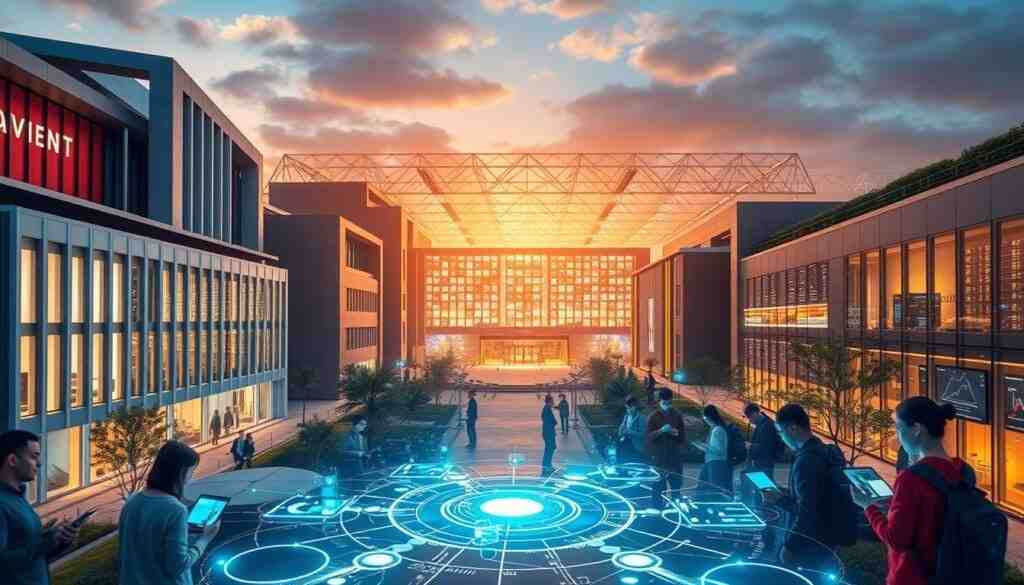Discover the Power of AI in Higher Education, Did you know 59% of colleges worry they’re falling behind in AI use? This shows how important artificial intelligence is for education. It can make things more efficient and help students do better. Rutgers University and Nova Southeastern University are already using AI to keep students on track and help them succeed.

Exploring AI in education, you’ll see how it can make things easier for staff. It can also make learning more personal and efficient. This guide will cover how AI can improve student engagement and make things run smoother. You’ll learn how to use AI to change your school for the better.
Discover the Power of AI in Higher Education, Key Takeaways
- AI adoption is key for colleges to stay ahead and help students succeed.
- AI can make learning more engaging, personal, and efficient for students.
- It can also help find students at risk and improve their chances of success.
- Having a plan for AI is vital to handle ethical issues and use AI wisely.
- AI tools can make administrative tasks easier, reducing mistakes and freeing up time.
- AI can give detailed data to teachers, helping them understand students better and improve learning.
- AI can change every part of learning, from how students engage to how courses are designed.
Understanding AI in Higher Education: A Fundamental Overview
Exploring AI in higher education is key. AI uses computer systems to do tasks that humans usually do, like learning and solving problems. It helps make learning better, improves student results, and makes school work more efficient.
The educational applications of ai are wide and varied. For example, AI tools can tailor learning to each student’s needs. Also, ai for university programs can automate tasks like grading, so teachers can focus on teaching.
AI systems use data analysis, machine learning, and natural language processing. These help AI learn, predict, and talk to people in a way that feels more human. Thinking about how AI can help in education is important.
- Personalized learning experiences
- Improved student outcomes
- Increased efficiency in administrative tasks
- Enhanced data analysis and decision-making
When looking into AI in education, think about how it can help your school. Consider the educational applications of ai and ai for university programs that fit your goals.
Discover the Power of AI in Higher Education, The Current State of AI in Higher Education
Institutions of higher education are changing with digital transformation in higher education. They are using artificial intelligence (AI) to make learning better. The benefits of ai in higher ed include personalized learning and better admin work. By September 2023, 49% of students and 22% of faculty were using generative AI regularly.
But, there are challenges. Schools must ensure AI is fair, transparent, and private. They also need to train faculty to use AI tools well. Despite these hurdles, the benefits of AI in education are big. Schools are investing in AI to improve many areas.
Different schools are adopting AI at different rates. Some are leading, while others are just starting. Here are some important stats on AI in education:
| Statistic | Percentage |
|---|---|
| Higher education students using generative AI regularly | 49% |
| Higher education faculty using generative AI at the same level as students | 22% |
| Institutions with no professional learning about using artificial intelligence in the classroom | 71% |
Transformative Benefits of AI-Powered Learning Systems
Exploring ai tools for learning and teaching reveals their power to change education. These platforms offer personalized learning, boosting student engagement and grades. For example, tools like Smart Sparrow and DreamBox adjust content for each student. This leads to better learning and success.
Also, ai teaching assistants, like Khanmigo, provide one-on-one help outside class. They help students grasp tough topics at their own speed.
The main advantages of ai in learning are:
- More student involvement and personal touch
- Smarter use of school resources
- Decisions based on real data
- Efficient use of time and effort
Using ai in education makes learning more effective and efficient. This leads to higher grades and more student success.
Discover the Power of AI in Higher Education, AI-Driven Educational Platforms Revolutionizing Teaching
Artificial intelligence is changing how teachers teach in higher education. Machine learning in academia is making learning more personal. This leads to better results for students. Over 50% of colleges in the USA are now using AI, showing it’s a growing trend.
AI in education has many benefits. For example, AI tools have helped students get better grades, with a 0.3 to 0.7 GPA increase. Also, AI early alert systems have cut dropout rates by 10%. These facts show AI’s positive effect on student success.
There are many AI-driven platforms in education. Adaptive learning systems adjust lessons based on how well students do. Khan Academy is one example, helping over 800,000 students improve their English. AI grading tools like Gradescope also save teachers a lot of time, letting them focus on teaching.
AI is making teaching more efficient and effective. It helps with administrative tasks and gives instant feedback. By using AI, teachers can create better learning environments. The future of education looks bright with AI, expected to grow to $207 billion by 2030.
Machine Learning Applications in Academic Assessment
Exploring ai in higher education shows how machine learning changes academic assessment. It makes grading more efficient and accurate. Machine learning algorithms help automate grading, reducing teacher workload and errors.
ai in education also brings performance analytics. This tool gives insights into how students learn and where they need help. It lets teachers create learning plans for each student and track their progress. This approach boosts student engagement and improves grades.
Discover the Power of AI in Higher Education, Automated Grading Systems
Automated grading systems use machine learning to check student work. This frees teachers to focus on teaching. It also helps make grading fair for all students.
Performance Analytics
Performance analytics helps teachers see how students are doing. It shows where students need extra help. This way, teachers can improve their teaching and help students learn better.
Discover the Power of AI in Higher Education, Predictive Student Success Models
Predictive models use machine learning to guess how students will do. They help teachers spot students who might struggle. This way, teachers can help more students succeed and improve education quality.
Implementing AI Solutions in University Programs
When thinking about adding AI to your university programs, plan carefully. You need a roadmap, to know where to start, and to train everyone. The digital transformation in higher education is happening, and AI is a big part of it.
The benefits of ai in higher ed are many. They include better student engagement, more efficient admin work, and smarter decisions. To get these benefits, schools must plan well and use AI wisely. This might mean buying new tech, training staff, and updating courses to teach AI.
Some schools, like Georgia State University, use AI to keep track of student attendance and make things run smoother. Others, like the University of Florida, add AI education to their courses. They have programs like AI Across the Curriculum.

To make AI work well, schools should follow these steps: * Make a detailed plan for using AI * Find out where you need to get better and focus on those areas * Train staff and students on AI * Keep updating courses to include AI knowledge By planning well, universities can use AI to improve education and drive digital transformation in higher education.
Digital Transformation Through AI: Best Practices
Starting your digital transformation with AI? It’s key to know the best ways to do it. Infrastructure requirements are vital. They help set up your ai tools for learning and teaching well. With the right setup, your platforms can grow, adapt, and last long.
Another important part is staff training and development. As ai tools get more common, your team needs to learn how to use them. They should know how to mix these tools into their teaching and improve student results.
Here are some top tips for AI-led digital transformation:
- First, figure out what you need for your ai platforms.
- Then, keep training your staff to use these tools well.
- Lastly, plan how to smoothly add these platforms to your teaching.
By sticking to these tips, you can make your digital transformation with AI a success. And your students will get to enjoy the perks of these advanced educational tools.
Discover the Power of AI in Higher Education, Addressing Privacy and Ethical Considerations
When using ai in higher education, it’s key to think about privacy and ethics. Artificial intelligence in schools collects data like personal info, grades, and how students act. This makes people worry about data leaks, misuse, and privacy breaches.
To fix these issues, schools need clear data privacy rules. They should say what data is gathered, how it’s used, and who sees it. Schools must also protect data with strong encryption and cybersecurity. It’s important to explain how ai works clearly to everyone.
- Keep detailed records of ai models, data, and how they make decisions
- Train teachers to use ai in a way that’s fair and helps students learn
- Make sure students or their parents know and agree to how their data is used
By focusing on these steps, schools can make sure ai is used right. This will help students learn better.
Discover the Power of AI in Higher Education, Measuring ROI of AI Implementation in Higher Ed
To get the most from AI in higher education, schools need to check how well AI tools work. This means looking at the return on investment (ROI) of AI, which can be tricky. Ellucian’s 2nd Annual AI in Higher Education Survey says schools can get the best ROI by picking AI uses that match their goals.
It’s important to regularly check how well AI models work. This helps make sure AI helps all students equally. With AI, schools can see better grades, test scores, and more students staying in school.
Some important things to think about when measuring ROI include:
- Setting clear goals for AI use
- Gathering and studying data on AI results
- Keeping up with how well AI works

By taking these steps, schools can make the most of their AI investment. This leads to better student results, more efficiency, and a stronger school reputation.
Discover the Power of AI in Higher Education, Overcoming Common Challenges in AI Adoption
When you start using ai tools for learning and teaching, you might face some hurdles. One big issue is the lack of technical know-how. This can make it hard to use machine learning in schools. To solve this, make sure your staff gets the training they need. This way, they can fully use the power of ai tools.
Another big challenge is the cost of adopting ai solutions. But, if you can show how ai tools will save money in the long run, you can get the funds you need.
Some people might also be hesitant to change. It’s important to talk to them and answer their worries. Show them how machine learning can help improve education. This will help you get more support for using ai in your school.
Here are some ways to tackle these problems:
- Provide ongoing training and support for staff
- Make a strong case for why you should use ai
- Engage with stakeholders to address their concerns
By tackling these challenges and using smart strategies, you can make ai tools a big part of your school. This will make learning better for your students and keep your school competitive in the world of machine learning.
Future Trends and Opportunities in Educational AI
Looking ahead, the future of ai in higher education is exciting. We’re seeing a rise in laws about using artificial intelligence in schools. This change will deeply impact how we teach and learn.
Clear policies on ai in education are on the horizon. They will help teachers and students use ai wisely. Also, ai literacy programs will start. They aim to teach everyone about ai’s benefits and risks.
Some big advantages of ai in schools include:
- Personalized learning experiences for students
- Improved administrative efficiency
- Data-driven decision making
- Enhanced student engagement and satisfaction
Research shows 70% of teachers think ai will make learning more personal. Schools using ai for tutoring see a 30% boost in student happiness. With ai growing fast in education, we’ll see even more cool uses soon.
Conclusion: Embracing the AI Revolution in Higher Education
This guide has shown how digital transformation in higher education and benefits of AI in higher ed are key for schools to stay ahead. The AI revolution can change higher education in big ways. It can make learning more engaging and tailored to each student, and also make school operations more efficient.
By welcoming this change, schools can open up new chances to improve learning, make decisions based on data, and encourage creativity. As AI changes how we teach and learn, schools need to start using these new tools. This will help prepare students for what’s next.
The future of school will focus on helping students become creators, not just skilled workers. By using AI wisely and thinking about ethics, schools can use this technology to help everyone learn. This way, schools can unlock the true abilities of their students.
FAQ
What is the role of AI in transforming higher education?
AI is changing higher education in big ways. It helps students learn better and makes school work more efficient. AI can tailor learning to each student, grade work automatically, and help make smart decisions with data.
How is AI being adopted in academia?
More schools are using AI, and it’s making a difference. Students are more engaged, and schools run smoother. But, schools face hurdles like setting up AI, training staff, and changing how they work.
What are the key components of educational AI systems?
Educational AI systems use data analysis, machine learning, and natural language processing. These tools help make learning personal, grade work automatically, and predict student success. They aim to improve learning and school efficiency.
How can AI-powered learning systems enhance the student experience?
AI learning systems make learning more engaging and personal. They adjust to how each student learns, give feedback right away, and offer content tailored to them. They also help schools run better, making decisions based on data and using resources wisely.
What are the applications of machine learning in academic assessment?
Machine learning helps with grading, analyzing student data, and predicting success. It makes grading fairer, more accurate, and faster. This helps students and schools alike.
What are the key considerations for implementing AI solutions in university programs?
To use AI in schools, you need a solid plan. This includes setting goals, finding areas to improve, and training staff. Schools must also think about privacy, measure AI’s value, and tackle common AI challenges.
What are the future trends and opportunities in educational AI?
The future of AI in education is bright. We’ll see more personal learning systems, adaptive platforms, and tools to help students succeed. As AI grows, schools will find new ways to teach and support students.






[…] an education loan provider, American Education Services can help you manage your student loans and financial […]
Pixel paradise! Dino Game brings joy through its perfectly crafted jumping mechanics.